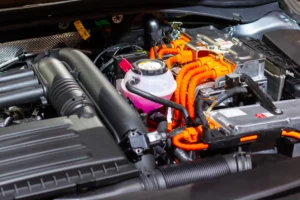Hybrid cars have become a staple in modern automotive design, offering drivers a balance between fuel efficiency and performance. Since their introduction to the mass market, hybrids have helped reduce greenhouse gas emissions and fuel dependency. But have you ever wondered exactly how hybrid cars work?
In this comprehensive guide, we’ll explore the ins and outs of hybrid technology — how it functions, its benefits, and why it’s played such a pivotal role in reshaping the way we drive.
What is a Hybrid Car?
A hybrid car combines two different power sources to propel the vehicle — a traditional internal combustion engine (ICE) and one or more electric motors powered by a battery. These systems work together (or independently) to maximize efficiency and minimize emissions.
Think of it as getting the best of both worlds: the range and familiarity of a gas engine, with the energy-saving efficiency of electric power.
Types of Hybrid Vehicles
There are several types of hybrid vehicles, each with different setups and benefits:
1. Full Hybrids (HEVs)
These can run solely on electricity, gasoline, or a combination of both. A well-known example is the Toyota Prius.
2. Mild Hybrids
The electric motor assists the gasoline engine but cannot power the car on its own. The Honda Insight (early models) was a mild hybrid.
3. Plug-In Hybrids (PHEVs)
These have larger batteries and can be plugged into an outlet to recharge. They run on electric power for short distances before switching to gas. Examples include the Toyota Prius Prime and Chevrolet Volt.
How Hybrid Cars Work: The Key Components
To understand how hybrid cars function, it’s important to look at the main components that power them:
1. Internal Combustion Engine (ICE)
Just like in a traditional car, this engine burns gasoline to produce energy. It kicks in when needed — especially during high speeds or low battery conditions.
2. Electric Motor(s)
Electric motors drive the wheels when the battery is charged, especially at low speeds or during initial acceleration. In full hybrids, they can sometimes power the vehicle alone.
3. Battery Pack
This is the heart of the hybrid system. It stores energy and powers the electric motor. In full hybrids and PHEVs, it’s a high-voltage battery — much larger than a typical 12V car battery.
4. Power Control Unit (PCU)
This component regulates energy between the battery, motor, and engine. It ensures the system is operating efficiently and manages the switch between power sources.
5. Regenerative Braking System
One of the most innovative features in hybrid cars. When you brake, the system captures kinetic energy and converts it into electricity, which is stored in the battery for later use.
How the Hybrid System Operates
Hybrid cars switch between electric and gas modes depending on driving conditions. Here’s a simplified breakdown:
- Starting / Low-Speed Driving: Electric motor only
- Cruising: Engine or electric motor (depending on load and battery level)
- Acceleration: Both engine and motor work together for extra power
- Braking / Deceleration: Regenerative braking charges the battery
- Stopped: Engine may shut off to save fuel (start-stop system)
This smart balancing act makes hybrid cars incredibly efficient, especially in city driving where stop-and-go traffic is common.
Benefits of Hybrid Cars
✅ Better Fuel Efficiency
Hybrids use less gasoline, especially in urban environments, resulting in major savings over time.
✅ Lower Emissions
Hybrids produce fewer greenhouse gases, contributing to cleaner air and a reduced carbon footprint.
✅ Reduced Engine Wear
Since electric motors handle some of the driving load, the gasoline engine endures less strain.
✅ Tax Incentives & Rebates
Many hybrids are eligible for government rebates, incentives, or reduced registration fees (varies by location).
Common Hybrid Car Myths Debunked
“They’re slow.“
Modern hybrids like the Toyota Camry Hybrid and Hyundai Sonata Hybrid are surprisingly quick and responsive.
“Battery replacement is expensive.“
True, batteries can be costly, but most hybrids come with 8–10 year warranties. Failures are rare within the warranty period.
“Maintenance is complicated.“
Hybrid maintenance is similar to regular cars — and in some cases cheaper due to less engine use.
Popular Hybrid Models from 2008
Here are a few standout hybrids from 2008 that made a mark:
- Toyota Prius
- Honda Civic Hybrid
- Ford Escape Hybrid
- Chevrolet Malibu Hybrid
- Nissan Altima Hybrid
These models set the foundation for what hybrid cars would become in the decades that followed.
What’s Next for Hybrid Technology?
As electric vehicles (EVs) gain traction, hybrid technology continues to serve as a transitional bridge. Brands like Toyota and Honda are still heavily investing in hybrid lineups, offering more power, longer electric-only ranges, and better fuel economy.
Even performance brands like Ferrari and McLaren use hybrid systems in their supercars — not just for efficiency, but to enhance acceleration and reduce turbo lag.
Conclusion
Understanding how hybrid cars work is more important than ever in today’s eco-conscious and fuel-sensitive world. Hybrid technology is a clever blend of innovation and practicality, and it’s here to stay — at least until full EV adoption becomes the norm.
Whether you’re a first-time car buyer, an environmental enthusiast, or just curious about the future of driving, hybrids offer a compelling option with tangible benefits.



